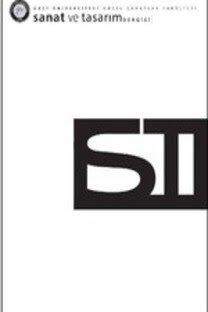Seramiğe Dönüşen Organik Nesneler: Teknik ve Sanatsal Örnekler
Seramik Bünye, Seramik Sanatı, Seramik Şekillendirme, Döküm Çamuru
Organic Objects Which Turn Into Ceramic: Technical and Artistic Examples
Ceramic Body, Ceramic Art, Ceramic Shaping, Slip Casting,
___
- Acartürk, B. ve Kaya Ş. (2013). Agrega Katkılı Seramik Bünye Özelliklerinin Araştırılması, Sakarya Üniversitesi Fen Bilimleri Dergisi, Cilt:17 Sayı:2, s.66
- Gürel, A. A. (2015). Seramik Sanatında Figüratif Form Olanakları Bağlamında Amiguruminin Kullanımı, Seramik Ana Sanat Dalı Yüksek Lisans Tezi, Eskişehir Anadolu Üniversitesi Güzel Sanatlar Enstitüsü, s.1, 32, 119, 120, 122, 128
- Kutlu, M. (2013). Resimsel Öğelerin Seramik Teknikleri ile Yorumu, Hacettepe Üniversitesi, Güzel Sanatlar Enstitüsü Seramik Ana Sanat Dalı, Sanatta Yüksek Lisans Tezi, Ankara, s.67-69
- Orlowski, J. M. (2010). Ties That Bind, A Thesis Submitted in Partial Fulfillment of the Requirements for the Degree of Masters of Fine Arts in the College of Arts and Sciences Georgia State University, Amerika, s.7
- Özer, L. ve Kurşuncu A. (2012). Kâğıt Katkılı Sanat Seramikleri, Anadolu Üniversitesi Sanat ve Tasarım Dergisi, Aralık, Cilt:3 Sayı:3, Eskişehir, s.121
- Peng, Q. (2016). A Site for Hybrid Practice: Between Traditional Culture and Contemporary Ceramic Art, An Exegesis Submitted For The Degree Of Thedoctor Of Philosophy Of Visual Arts Graduate Program Doctor Of Philosophy The Australian National Unıversity, College Of Arts And Social Sciences Research School Of Humanities And The Arts School Of Art, Avustralya, May, s. 48,116,133-134,144, 221, 233
- http-1: https://www.foodelphi.com / malzeme – bilgisi - doc- dr-ali - gundogdu / Organik (Erişim tarihi 19.11.2018)
- http-2: http://www.kimyaegitimi.org / sites / default / files / kimya_egitimi_ ogrenci_ deneyleri / organik _ bilesiklerde _ karbon_ve_ hidrojen.pdf (Erişim tarihi 19.11.2018)
- http-3: http://ceramicartistsnow.com / wp-content / uploads / 2016/02/10 – cool – ceramic -CAN. pdf 10 Unconventional Ceramic Techniques You Haven’t Tried Yet (Erişim tarihi 06.10.2018)
- http-4: http://www.jessicadrenk.com/#/schwane/ (Erişim tarihi 06.10.2018)
- http-5: http://jessicagardnerstudios.com/ (Erişim tarihi 08.10.2018)
- http-6: http://www.themethodcase.com/else-by-michal-fargo/ (Erişim tarihi 21.10.2018)
- http-7: http://www.mettemayagregersen.com/wordpress/construtions/ (Erişim tarihi: 21.10.2018)
- GÖRSEL KAYNAKÇA
- Görsel 1. Peng, Q. (2016). A Site for Hybrid Practice: Between Traditional Culture and Contemporary Ceramic Art, An Exegesis Submitted For The Degree Of Thedoctor Of Philosophy Of Visual Arts Graduate Program Doctor Of Philosophy The Australian National Unıversity, College Of Arts And Social Sciences Research School Of Humanities And The Arts School Of Art, Avustralya, May, s.221
- Görsel 2. Peng, Q. (2016). A Site for Hybrid Practice: Between Traditional Culture and Contemporary Ceramic Art, An Exegesis Submitted For The Degree Of Thedoctor Of Philosophy Of Visual Arts Graduate Program Doctor Of Philosophy The Australian National Unıversity, College Of Arts And Social Sciences Research School Of Humanities And The Arts School Of Art, Avustralya, May, s.144
- Görsel 3. Peng, Q. (2016). A Site for Hybrid Practice: Between Traditional Culture and Contemporary Ceramic Art, An Exegesis Submitted For The Degree Of Thedoctor Of Philosophy Of Visual Arts Graduate Program Doctor Of Philosophy The Australian National Unıversity, College Of Arts And Social Sciences Research School Of Humanities And The Arts School Of Art, Avustralya, May, s.233
- Görsel 4. Demet İper Dicle Kişisel Arşivi Görsel 5. Demet İper Dicle Kişisel Arşivi
- Görsel 6. Kutlu, M. (2013). Resimsel Öğelerin Seramik Teknikleri ile Yorumu, Hacettepe Üniversitesi, Güzel Sanatlar Enstitüsü Seramik Ana Sanat Dalı, Sanatta Yüksek Lisans Tezi, Ankara, s.67
- Görsel 7. http://galerisoyut.com.tr / artist / betul- demir - karakaya / # gallery / 057284 e 94f 9b8b5 aa 9e538f9 eb 0af949 / 6564 (Erişim Tarihi 06.10.2018)
- Görsel 8. http://jessicadrenk.com/pages/Porcelain%20Skins/Skin%2003.html (Erişim Tarihi 06.10.2018) Görsel 9. http://jessicagardnerstudios.com/gallery-growing-up/ (Erişim Tarihi 06.10.2018)  Görsel 10. http://jessicagardnerstudios.com/gallery-growing-up/ (Erişim Tarihi 06.10.2018) Görsel 11. Michal Fargo Kişisel Arşivi
- Görsel 12. Michal Fargo Kişisel Arşivi
- Görsel 13. AU Ho Lam Suzanne Kişisel Arşivi
- Görsel 14. AU Ho Lam Suzanne Kişisel Arşivi
- Görsel 15. Gürel, A. A. (2015). Seramik Sanatında Figüratif Form Olanakları Bağlamında Amiguruminin Kullanımı, Seramik Ana Sanat Dalı Yüksek Lisans Tezi, Eskişehir Anadolu Üniversitesi Güzel Sanatlar Enstitüsü, s.128
- Görsel 16. Mette Maya Gregerson Kişisel Arşivi Görsel 17. Mette Maya Gregerson Kişisel Arşivi Görsel 18. Deborah Timperley Kişisel Arşivi Görsel 19. Seyhan Yılmaz Kişisel Arşivi
- Görsel 20. Seyhan Yılmaz Kişisel Arşivi
- ISSN: 1308-2264
- Yayın Aralığı: 2
- Başlangıç: 2015
- Yayıncı: Ankara Hacı Bayram Veli Üniversitesi
Tarihi ve Kültürel Mekanların Sergi Alanı Olarak Kullanımında Yaşanan Sorunlar: Kktc Örneği
Seramiğe Dönüşen Organik Nesneler: Teknik ve Sanatsal Örnekler
Artistik Seramiklerde Alternatif Bir Malzeme Olarak Lületaşı Kullanımı
Sıdıka Sibel SEVİM, Selim ÇINAR
Fatma ÇİFTÇİ, Mustafa AĞATEKİN
Sanat Yoluyla Düşünme: Su Örneği
İsmail EYÜPOĞLU, Feryal BEYKAL ORHUN
Peyzaj Mimarlığında Su Öğesinin Tarihsel Süreçteki Kullanım Amaçları
Tuğba DÜZENLİ, Elif Merve ALPAK, Duygu AKYOL
Seramik Yüzeylerde Dijital Baskı Uygulamaları
GELENEKSEL ÇÖMLEKÇİLİKTEKİ SU KAPLARI VE ANADOLU, HİNDİSTAN, İSPANYA ÖRNEKLERİ
19. ve 20. Yüzyıllarda Harput Bölgesinin Tekstil Sektöründeki Ticari Gelişmeleri
